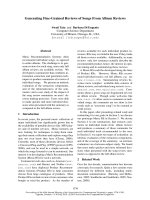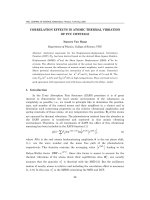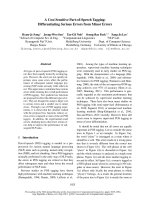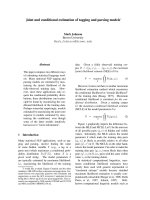Báo cáo " Margin deltas in the northern part of the Red River basin " doc
Bạn đang xem bản rút gọn của tài liệu. Xem và tải ngay bản đầy đủ của tài liệu tại đây (343.21 KB, 10 trang )
VNU Journal of Science, Earth Sciences 24 (2008) 16-25
16
Margin deltas in the northern part
of the Red River basin
Doan Dinh Lam
1,
*
, Nguyen Trong Tin
2
, Nguyen Thi Hong
2
1
Institute of Geological Sciences, Vietnamese Academy of Science and Technology
2
Vietnam Petroleum Institute, Vietnam Oil-Gas Group
Received 20 February 2008; received in revised form 15 March 2008
Abstract. Margin deltas are the last ones that were formed in a shelf break zone, when a sea level
has slowdown during last time of a forced regression and the beginning of the success
transgression. The margin deltas are abruptly thickened in the zone of shelf break, became thinner
landward and basinward. Because they were formed in the shelf edge, they have a relatively high
sand/clay ratio, prone to turbidite.
In the northern part of the Red River basin, during the Miocene the margin deltas had
developed eastward from the plot 103, i.e. from the borehole 103-TH-1X, 103-TG-1X and 103-HOL
seaward.
An existence of the margin deltas in this region confirms a presence of the basin floor fans in
the central part of basin - very important objects for oil-gas prospecting.
Keywords: Margin delta; Delta front deposit; Red River basin;
1. Introduction
*
When sea-level slowdowns in the
transgression-regression cycle, especially due
to lowering sea level, a shelf was exposed and
a series of deltas were formed. A margin
delta is the last one that was formed during
the last time of lowstand stage and early time
of the next transgression stage. There are
some papers dealing with margin deltas [5,
6]. The margin deltas are well developed with
a width of tens kilometers and thickness
reached hundreds meters, their slope is about
3-6
0
. A study of margin deltas has an
_______
* Corresponding author. Tel.: 84-4-7754608
E-mail:
important role in prospecting and exploration
oil and gas on the shelf. A presence of the
margin deltas will help in determining
whether there is a basin floor fan - an
important object in oil and gas prospecting.
Furthermore, themselves, they are also
subject of prosperous potential of oil and gas.
For the first study of margin deltas in the
northern part of the Red River basin, the
Miocene deposits in the northern part of the
Red River basin - where a continental shelf
was well developed and has a high potential
of oil and gas - were chosen. The data used in
this study was collected from Vietnam
Petroleum Institute and other publications.
Doan Dinh Lam et al. / VNU Journal of Science, Earth Sciences 24 (2008) 16-25
17
2. Some characteristics, forming process and
development of the margin deltas
Most of margin deltas were developed in a
passive margin area. These deltas have a lob or
multilob form and stretched along strike [5, 6].
The length of these margin deltas often
reached 30-50 km and their width is of tens, or
even hundred kilometers (Fig. 1).
Fig. 1. Geometry of margin deltas: A-Mexican gulf, B-Mississippi (S.J. Porebski, R.J. Steel, 2001).
The thickness of the margin deltas is
about 50-70m, even somewhere it reached
more than 150m. On seismic profiling, their
refections are from oblique to tangential form,
dipping to the basin, ended by toplap under
erosion plane. A key facies complex of the
margin deltas is a complex of river mouth
bars and delta front/slope deposits.
Landward, a river mouth bars consist of fine
to medium sands with a high thickness.
These sands are more or less clean, wave
bedding or parallel, plane or oblique bedding
with a low slope. Delta front deposits are
underlain by shelf deposits that were formed
before and consist of thick sand layers.
Because delta front deposits of margin delta
are underlain by previous formed deltaic
deposits, so normally they are consist of very
thick sand layers and also turbidities.
Margin deltas are different from inner
deltas by the following features:
- Margin deltas have a multilobe or
accurate to lunate bodies while inner self
deltas have a horsetail form.
- The size of clinoform wedges with a
maximum thickness at shelf break is much
more bigger than the inner or middle shelf
delta, reached hundreds meters comparing to
tens meters of the last.
- In dip direction, margin delta deposits
are thicken as a clinoform wedge towards the
shelf edge and became thin gradually down
into upper slope deposits.
- Sigmoidal dip cross-section.
- The most distinctive feature of the
margin delta is their strike-elongate form
Doan Dinh Lam et al. / VNU Journal of Science, Earth Sciences 24 (2008) 16-25
18
along shelf edge and could reach 30-90 km.
The isopach of the margin delta deposits have
a strike elongate form and are augmented by
faults.
- Landward these deposits are pinchout
by onlap onto shelf shales and basinward the
shelf delta deposits pinchout by downlap to
hemipelagic shales.
- There is an evidence of shortenning in
stratigraphy.
- The delta front/prodeltaic deposits of the
margin delta are prone to turbidite.
- The abundance of so called soft deformation
of the deposits related to the slope.
- The absence of a horstail paralic along
shelf edge.
Margin delta forming process and
evolution history are closely related to a
forced regression of the sea level during the
late time of the lowstand stage, beginning
time of the transgression stage (Fig. 2).
Fig. 2. Forming processe of a margin delta related to
sea-level change (Porebski, Steel, 2001).
Margin delta deposits were formed in
relatively deep water and are wide spread in
the shelf area, where strong subsidence
occurred. The margin deltas are composed of
a series wedges, the upper boundary of
which is a trace of sediment supply or of
complex erosion/transgressive erosion.
Because margin deltas are formed in the shelf
break zone so their thickness is abruptly
increased at the shelf break and deltaic
clinoforms have bigger size compared to
others. When deltas have reached to the shelf
margin as a result of lowering sea-level,
heterolithic delta front deposits with small
bedding became more turbidite because
supplied rivers will debouch directly to a
slope area, which has a longer distance and
higher slope, creating a good condition for a
hyperpicnal flow. This is why the clinoforms
of margin deltas have a bigger size compared
to others.
3. Some geological characteristics of study area
The study area includes zones 102, 103,
104 and a west part of zone 107 (Fig. 3). The
sea depth is from 40-50m to 80-100m. Oil and
gas prospection and exploration in this area
were started from an earlier time.
Since 80-s of the 20 century, a prospect
was carried out more intensively. Foreign
investors and Vietnamese prospectors had
carried out thousands kilometers of 2D and
hundreds kilometers of 3D seismic profiling.
Many deep boreholes were set up for
investigation oil-gas potential of the
Vietnamese shelf. Although investigations in
different zones were not at the same level but
results of these investigations have revealed
some geological characteristics and evolution
of the Red River basin in general.
Geochronologically, the Miocene deposits
Doan Dinh Lam et al. / VNU Journal of Science, Earth Sciences 24 (2008) 16-25
19
were divided into 3 units as follow:
3.1. Phong Chau Formation (N
1
1
pch)
This formation was established in 1972 by
Palustovich and Nguyen Ngoc Cu, based on
cross-section from 1,820m to 3,000m of the
borehole GK 100 in Phong Chau District, Thai
Binh Province. This cross section is
characterized by intercalated of medium to
fine grained sandstones of grey to whitish,
dark green color with silty sandstones with
very thin stratification, from some millimeters
to some centimeters, that formed an "eye"
structure, lenses or wave and called a
“striped” rock. A cement of sandstones is
mainly carbonate with high content (25%).
Secondary minerals are glauconite and pyrite.
The thickness of formation reached 1,180m.
The Phong Chau Formation is distributed
mainly in Khoai Chau - Tien Hai area and
developed to the Bac Bo Gulf (Borehole 103-
TH). It is composed of sandstones, silty
sandstones and claystones with some coal
traces or thin limestones (borehole 103-TH,
103-HOL). Their cement is carbonate.
Claystones are light grey, brownish red,
parallel or wavy stratification. Their
composition is composed mainly of kaolinite
and illite.
Fig.3. A study area.
In the seismic cross-sections, Phong Chau
Formation is appeared as a parallel reflection
with a good continuity. Based on
palynological analysis, Phan Huy Quynh and
Do Bat (1985, 1993, 1995) have established a
complex of Betula- Alnipollenites and zone
Doan Dinh Lam et al. / VNU Journal of Science, Earth Sciences 24 (2008) 16-25
20
Florschuetzia levipoli of early Miocene.
Deposits of Phong Chau Formation were
formed in the deltaic condition and shelf
(Borehole 104), with some phases of
transgression (borehole 100). Marine deposits
increased seaward. They are underlain with
unconformity by Dinh Cao Formation or
older rocks.
3.2. Phu Cu Formation
The Phu Cu Formation was established by
Golovenok V.K and Le Van Chan in 1966,
who first time described this formation from
borehole GK 2 (from 960m to 1,180m) in Phu
Cu structure of Ha Noi Depression. However,
at this time a bottom of this formation was
not clear. The formation is consists of
deposits that are characterized by clear
cyclicity of medium sandstones, silty
sandstones with thin stratification (wavy,
lenses, cross bedding), silstones, claystones of
massive structure, contain a lot of flora,
bottom animals, foraminifers and thin beds of
lignites. Sandstones are monominerals, well
sorted and rounded. Beside turmaline, zircon
as secondary minerals somewhere glauconite
and garnet are occurred. Later, after careful
check of all cross sections of Phu Cu Formation
of the deep boreholes that penetrated across
the whole formation, Phan Huy Quynh and
Do Bat (1983) and Le Van Cu (1985) have
divided the Phu Cu formation into 3 parts
according to cyclicity point of view. Each part
consists of sandstone, siltstone, claystone
contain coal and flora fossils. Somewhere
foraminifers and brackish molluscs are
occurred.
The Phu Cu deposits are wide spread in
Hanoi Depression. Its thickness became lower
in Dong Quan area and higher seaward in
Bac Bo Gulf. Deposits consist of sandstones,
silty claystones, coals and somewhere thin
layers of carbonates. Sandstones have a light
grey to light green color. They are fine to
medium grainsized, average to well sorted.
Their typical feature is thin bedding. There
are siderite nodules or glauconites (boreholes
GK 100, 102, 110, 104). A carbonate cement of
sandstone is abundant, clay cement is rare.
Silty claystones are light grey to dark grey
color, contain a little of carbonates, flora and
coals (borehole GK 103-TH). The thickness of
this formation is varies from 1,500m to
2,000m. This formation is distinguished by a
high content of organic matter, about
0.86%wt, that reached a criterion of source
rocks and in fact, in Hanoi Depression, oil
and condensats were found in this formation.
On seismic cross-sections, deposits of this
formation are displayed as a parallel or
chaostic reflectors with high amplitude and
frequency that related with coal bearing
layers. Their Middle Miocene was established
based on a complex of fossils: Florshuetzia
trilobata and Fl. Semilobata and Globorotralia
mayeri, Orbulina universa.
The Phu Cu Formation is conformably
underlain by the Phong Chau Formation and
was formed in the deltaic and shelf condition
with some phases of marine transgressions.
Seaward to the Bac Bo Gulf, these deposits
have changed into underwater delta, delta
front deposits.
3.3. Tien Hung Formation
The Tien Hung Formation was
established by Golovenok V.K and Le Van
Chan (1966) and its name - Tien Hung is a
locality of Thai Binh Province, where its
stratotype was established in the borehole
GK-4 from 250m to 1,010m. The Tien Hung
Formation consists of deposits that have very
Doan Dinh Lam et al. / VNU Journal of Science, Earth Sciences 24 (2008) 16-25
21
clear cyclicity. Each cycle started by brecia,
sandstones that changed into silstones,
claystones with some lignite layers. The
thickness of coarse deposits is thicker than
finegrained deposits. The amount of observed
cycles in this formation is 15-18. Sandstones
and brecias are weekly cemented, bad sorted
and rounded, contain many garnets. There
are sandstones of whitish grey color contain
siderites nodules in the lower part. The
thickness of the formation in this borehole is
about 760m.
Because of facies change, it is difficult to
determine the boundary between Tien Hung
and Phu Cu formations. In the lower part of
Tien Hung Formation, Phan Huy Quynh and
Do Bat (1985) have found a layer of grey
sandstone, contains a marks of leaves that is
quite widely occurred in the most boreholes
in the Hanoi Depression. They consider it as a
sign of change to continental condition after
forming the Phu Cu Formation. The bottom
of this sandstone is regarded as a lower
boundary of the Tien Hung Formation. The
Tien Hung Formation is widely distributed in
most boreholes of the Hanoi Depression and
offshore in Bac Bo Gulf. Sandstones of this
formation have a thick to massive
stratification, light grey color to greenish
grey, average to bad sorted. Their cement is
carbonate or clays. Silty claystones have a
dark grey to light grey color, somewhere
brownish grey, dark grey (Borehole 104, 102-
HD), contain coals and fossils with
glauconites and pyrites (boreholes 100, 103-
TH). Total thickness of this formation is
varied from 760m to 3,000m.
On seismic cross-sections, the Tien Hung
Formation is displayed as a sequence with a
weak stratification, high amplitude. The Tien
Hung Formation has a contact with the
underneath Phu Cu Formation by an
unconformity that has a sign of regression in
uplift zone with two phases of non-continuity
reflectors. Fossils founded in the Tien Hung
Formation consist of a mark of flora, spore
and pollens, foraminifers and nanoplankton.
A typical complex was found in medium
sandstones such as Quercus lobbii, Ziziphus.
This layer is occurred widely in the Hanoi
Depression as well as in the North Vietnam
such as in Tam Cha (Na Duong, Lang Son),
Bach Long Vi, Trinh Quan (Phu Tho). The
Late Miocene age of this formation was
established based on a pollen spore complex:
Dacrydiumllex, Quercus, Florschuetzia trilobata,
Acrosticum, Stenochlaena as well as a
foraminifer complex: Pseudorotalia sp.,
Ammonia sp Depositional environment of this
formation is mainly deltaic with some phases of
shallow marine and underwater deltas.
4. Sea-level fluctuation and formation of
margin deltas in the northern part of the
Red River basin
A study result on the Red River basin has
revealed 8 transgression/regression cycles
during the Miocene. There are 2 cycles in
Early Miocene, and 3 cycles in Middle and
Late Miocene [1, 2, 4]. Among these cycles,
the ones in Middle Miocene are most
developed. During transgression, the sea
level was higher the recent one. The study on
sea-level fluctuation in the region,
characteristics of the upper surfaces of Upper,
Middle and Lower Miocene deposits (Fig. 4),
as well as study on lithological features,
depositional facies, structures, of the
boreholes 102-CQ-1X, 102-HD-1X, 103-TH-1X,
103-TG-1X, and 103 HOL-1X, had revealed
that in Early Miocene in northern part of the
Red River basin, margin deltas have
Doan Dinh Lam et al. / VNU Journal of Science, Earth Sciences 24 (2008) 16-25
22
developed only eastward from plot N
0
103,
i.e. from borehole 103 HOL seaward. During
Middle and Late Miocene, the margin deltas
had developed eastward from borehole 103-
TH-1X and 103-TG-1X. A slope of shelf
during Late Miocene was 4-5
0
at borehole
103-TH-1X and 103-TG-1X and this was a
shelf break.
Fig. 4. Isoliths of the upper surfaces of Miocene
deposits in the Northern part of the Red River basin.
(A-Lower Miocene; B-Middle Miocene; C-Upper Miocene)
5. Some features of margin deltas in the
northern part of the Red River basin
In the northern part of the Red River
basin, margin deltas have developed
eastward from the borehole 103-TH-1X. They
are composed of river mouth bars and delta
front deposits. According to obtained results
from boreholes, in the study area the upper
part of the second sequence of the Phong
Chau Formation from borehole 103-TH-1X,
second sequence of the Phong Chau
Formation of borehole 103-TG-1X, upper part
of the first sequence of the Phu Cu Formation
(borehole 103-TH-1X and 103-TG-1X) are
river mouth bars (Fig. 5). These river mouth
bars consist of fine to medium grained sands
(varied from 35% to 40%). Sands are clean,
well to average sorted, light grey color. The
cement are calcite, silic and clay, contain
mica, glauconite. River mouth bar have a
very thick sands (10-20m), coarsening
upward. Bioturbation in the lower part is
week and sands do not contain fossils, or
some scared bivalves and flora. Sands have a
parallel, wavy bedding or even massive
structure. Their seismic specific features show
divergent, not continuous with amplitude
from average to high, low frequency and high
speed (5.7km/s). The thickness of river mouth
bars are of 15-20 to 30-40m. Geochronologically,
the river mouth bars are overlain by delta
front deposits. Delta front deposits became
thinner in both sides and changed to claystone,
silty claystone with thin stratification of inner
or middle shelf deposits.
In the study area, delta front deposits are
distributed as follow:
In the borehole 103TH-1X, delta front
deposits are third sequence of the Phong
Chau Formation, second sequence of the Phu
Cu Formation and first sequence of the Tien
Hung Formation. In the borehole 103-TG-1X,
the sediments of the second and third
sequences of the Phong Chau Formation, first
and second sequences of the Phu Cu
Formation and third sequence of the Tien
Hung Formation are delta front deposits.
In the borehole 103-HOL, as the delta front
deposits can be considered sediments of the
third sequence of the Phu Cu Formation and
third sequence of the Tien Hung Formation.
These delta front deposits consist of silty sands,
sandy silts, fine sands, poorly fossiliferous.
Doan Dinh Lam et al. / VNU Journal of Science, Earth Sciences 24 (2008) 16-25
23
They composed the progradational wedges,
thickness of which increased seaward (Fig. 7).
The sand/clay ratio changed from 40% (103-TH-
1X) to 35% (103-TG-1X).
Fig. 5. Sand mouth bar and its well logs (Borehole 103-TH-1X).
The sands are clean, fine to medium
grained, average to poorly sorted of light
grey, grey color. These sands are weekly
consolidated; they contain mica, pyrite,
siderites, glauconites and montmorillonites.
The sands are mostly feldspathic litharenite
and litharenite. Most sand layers have a
thickness from 10-20m to 60m (103-TH-1X),
(Fig. 8). The amount of fossils in delta front
deposits is much more abundant than in
sand-mouth bar. Delta front deposits are thin
bedded, parallel laminated to wavy. Thin
beds of parallel laminated sands and thick
clay mud layers, none or poorly bioturbated
here is interpreted as delta front turbidites
deposits (Fig. 6).
Most abundant phenomena in delta front
deposits is a slump, that makes delta front
deposits of margin delta are prone to
turbidite and why a slump is a very typical
characteristic of margin delta. Because when
reached to the shelf edge a slope will be
changed very quickly, creating a good
condition for a slump to develop.
The well logs of the delta front deposits
have a bell, tunnel, symmetric saw-tooth
forms. On the seismic cross-sections, the delta
front deposits show a mound, non
continuous with a high to average amplitude
and average frequency (Fig. 6 and 7), V=2.5-
2.7km/s in the borehole 103-TG-1X and
radiate and mound form, average continuity,
high amplitude, V= 2.2-2.4km/s in the
borehole 103-TH. Sands are stratified
differently, some sandlayers in borehole 103-
TH have a thickness over 20m, even reached
60m, in others they are thinner, less than 20m.
Deposits contain foraminifers such as
Ammonia sp., Pseudorotala sp., Quinqueloculina
sp., Cyclmmina sp., Globigerinoides sp., and
some spore and pollens: Florschuetzia
meridionalis, Florschuetzia levipolis, Florschuetzia
trilobata, (103-TG-1X, 103-TH-1X).
Doan Dinh Lam et al. / VNU Journal of Science, Earth Sciences 24 (2008) 16-25
24
Fig. 6. Turbidites of the Upper Miocene (Cross-section GPGT93-201).
Fig. 7. Progradational wedge of the shelf-margin delta.
Fig.8. Delta front sands, sandy silts and well logs (borehole 103-TG-1X)
Doan Dinh Lam et al. / VNU Journal of Science, Earth Sciences 24 (2008) 16-25
25
6. Conclusions
- In the northern part of the Red River
basin, during the Miocene, margin deltas
have developed eastward from the plot
N
0
103. These margin deltas were formed and
developed at the end of the lowstand stage,
beginning of the transgressive stage. A
thickness of these delta deposits varied from
40-60 to 80-100m.
- An existence of the margin deltas in
Miocene in the northern part of the Red River
basin confirms a presence of basin floor fans
in the central part of the Red River basin.
These basin floor fans are important objects of
oil-gas prospecting that need to take in
account.
Acknowledgements
This paper was completed within the
framework of Fundamental Research Project
709306 funded by Vietnam Ministry of
Science and Technology.
References
[1] Nguyen Thi Hong, Study, application of sequence
stratigraphy in analysis oil-gas systems of the
Neogene deposits in the northern part of the Red
River basin, MSc thesis, College of Science, VNU,
Hanoi, 2007 (in Vietnamese).
[2] Bui Van Thanh, Cao Van Dao, Determine
transgressive/regressive sequences in the
Neogene deposits in borehole columns.
Proceedings of the Congress ”30 years of
Vietnamese oil-gas, new chances and challenges”
Hanoi, 2005 (in Vietnamese).
[3] Tran Huu Than, Geological evolution and oil-gas
potential of the Red River basin, Scientific report,
Archive in the Vietnam Petroleum Institute,
2004 (in Vietnamese).
[4] Nguyen Trong Tin, Nguyen The Hung, Tran Huu
Than, Do Bat, Doan Dinh Lam, Application of
sequence stratigraphy in prospecting oil-gas in the
northern part of the Red River basin, some
examples, Journal of Oil - Gas 1 (2006) 15 (in
Vietnamese).
[5] J.R. Suter, J.R. Berryhill, Late Quaternary margin
deltas, northwest gulf of Mexico, Americal
Association of Petroleum Geology Bull. 69 (1985) 77.
[6] Szczepan J. Porebski, Ronald J. Steel, Margin
deltas: their stratigraphic significance and
relation to deepwater sands, Earth Science
Reviews 62 (2001) 283.









